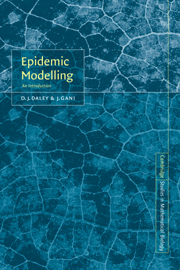2 - Deterministic Models
Published online by Cambridge University Press: 16 November 2009
Summary
In deterministic models, population sizes of susceptibles, infectives and removals are assumed to be functions of discrete time t = 0, 1, 2, … or differentiable functions of continuous time t ≥ 0. Such approximations to the true, integer-valued numbers of individuals involved in an epidemic, allow us to derive sets of difference or differential equations governing the process. The evolution of this epidemic process is deterministic in the sense that no randomness is allowed for; the system develops according to laws similar to those for dynamical systems. It is usual to regard the results of a deterministic process as giving an approximation to the mean of a random process: there are examples related to this in the next chapter (see equations (3.2.4) and (3.3.6), and Exercises 3.1, 3.2, 3.5 and 3.11).
The simple epidemic in continuous time
A simple epidemic is one where the population consists only of susceptibles and infectives; once a susceptible is infected, it becomes an infective and remains in that state indefinitely. A simple epidemic may be thought of as one where
(a) the disease is highly infectious but not serious, so that infectives remain in contact with the susceptibles for all time t ≥ 0;
(b) the infectives continue to spread their infection until the end of the epidemic (see equation (2.1.2) and below for interpretations of the ‘end’ of the epidemic).
An infection which may approximate these conditions is the common cold over a period of a few days. This simple epidemic model is the same as the logistic model of population growth, attributed to Verhulst (1838).
Information
- Type
- Chapter
- Information
- Epidemic ModellingAn Introduction, pp. 20 - 55Publisher: Cambridge University PressPrint publication year: 1999
